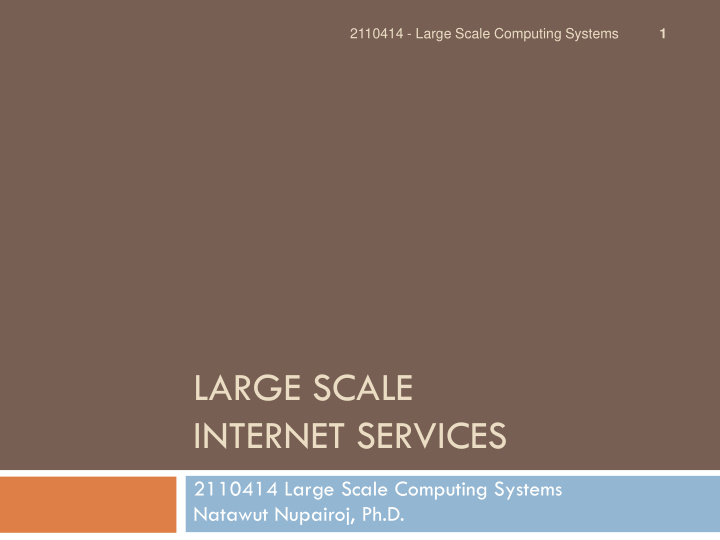



2110414 - Large Scale Computing Systems 1 LARGE SCALE INTERNET SERVICES 2110414 Large Scale Computing Systems Natawut Nupairoj, Ph.D.
Outline 2 Overview Background Knowledge Architectural Case Studies Real-World Case Study 2110414 - Large Scale Computing Systems
Overview 3 2110414 - Large Scale Computing Systems
Overview 4 Internet services become very essential and popular Google serves hundreds of millions of search requests per day Main requirements Availability Scalability 2110414 - Large Scale Computing Systems
Internet Service Application Characteristics 5 2110414 - Large Scale Computing Systems
Background Knowledge 6 2110414 - Large Scale Computing Systems
Multi-Tier Architecture 7 2110414 - Large Scale Computing Systems
Web Based Architecture Revisited 8 search.jsp search.jsp - params Request Web AppServer Server Web Browser Response HTML page 2110414 - Large Scale Computing Systems
9 2110414 - Large Scale Computing Systems
System Availability How to ensures a certain absolute degree of operational continuity during a given measurement period Availability includes ability of the user community to access the system, whether to submit new work, update or alter existing work, or collect the results of previous work Model of Availability Active-Standby: HA Cluster or Failover Cluster Active-Active: Server Load Balancing 2110684 - Basic Infrastructure
HA Cluster Redundant servers and other components Only one server is active (master) One server is standing-by Shared storages Pro: Simple Half software license costs Con: Double hardware cost with single performance 2110684 - Basic Infrastructure
Server Load Balancing 12 Spread work between two or more computers, network links, CPUs, hard drives, or other resources, in order to get optimal resource utilization, throughput, or response time Approaches DNS Round-Robin Reverse Proxy Load Balancer 2110684 - Basic Infrastructure
DNS Round-Robin 13 2110414 - Large Scale Computing Systems
DNS Round-Robin 14 Pro: Inexpensive Con: Load distribution, but not high availability Problem with DNS caching 2110414 - Large Scale Computing Systems
Reverse Proxy 15 2110684 - Basic Infrastructure
Server Load Balancing 16 Special equipment “load balancer” to distribute request to servers Clients will see only single “virtual” host based on “virtual” IP 2110684 - Basic Infrastructure
Stateful vs. Stateless Servers 17 Stateful server server maintains some persistent data Allow current request to relate to one of the earlier requests, “session” Stateless server server does not keep data A request is independent from earlier requests Example: Web server, NFS 2110684 - Basic Infrastructure
Stateful Servers 18 Server has to maintain some “session” information of each connection connect Current request may depend use db1 on previous requests Database Consume server’s resources Server select * from … (memory, TCP port, etc.) disconnect Lead to limit number of clients it can service Example: Database, FTP If connection is broken, the service is interrupted 2110684 - Basic Infrastructure
Stateless Servers 19 Server does not maintain information of each connect connection GET /index.html Connect-request-reply- disconnect disconnect cycle Web Server connect Consume less server’s resources GET /i/logo.jpg Lead to large number of disconnect clients it can service Example: Web server, NFS 2110684 - Basic Infrastructure
Web Caching 20 Utilize the fact that LAN has more bandwidth and less accessing latency than WAN t = accessing latency + data size / bandwidth Web pages usually have some “popularity” User usually goes back-and-forth between pages Users tend to share the same interest (fashion) 2110414 - Large Scale Computing Systems
Web Page Popularity 21 Source: http://www.useit.com/alertbox/zipf.html 2110414 - Large Scale Computing Systems
Web Caching Mechanism 22 Source: http://en.wikibooks.org/wiki/Computer_Networks/HTTP
Web Caching Location 23 Source: http://knowledgehub.zeus.com/articles/2009/08/05/cache_your_website_for_just_a_second 2110414 - Large Scale Computing Systems
Architectural Case Studies 24 D. Oppenheimer and D. Patterson , “ Architecture and Dependability of Large- Scale Internet Services”, IEEE Internet Computing, Sept-Oct 2002 2110684 - Basic Infrastructure
Case Studies 25 Online - an online service/Internet portal (Hotmail) Content - a global content-hosting service (File sharing) ReadMostly - a high-traffic Internet service with a very high read-to-write ratio (Wikipedia) 2110414 - Large Scale Computing Systems
Site Architecture 26 Load balancing servers Front-end servers Run stateless codes to service requests and gather data from back-end servers Web server / AppServer Back-end servers Provide persistent data (databases, files, emails, user profiles) Should utilize RAID-based storages 2110414 - Large Scale Computing Systems
Front-end: functional partitioned Online Site Back-end: single file, single database 27 2110414 - Large Scale Computing Systems
Front-end: all the same Back-end: data partitioned 28 2110414 - Large Scale Computing Systems
Front-end: all the same ReadMostly Back-end: full replication 29 2110414 - Large Scale Computing Systems
Real-World Case Study: eBay 30 R. Shoup and D. Pritchett, “The eBay Architecture”, SD Forum 2006 2110414 - Large Scale Computing Systems
eBay 31 Lots of workloads 212 millions registered users 1 billion page views a day 2 petabytes of data Large number of servers 15,000 AppServers (IBM WebSphere) 100 database servers (Oracle) Utilize Akamai (CDN) for static contents 2110414 - Large Scale Computing Systems
CDN: Akamai Source: http://en.wikipedia.org/wiki/Akamai_Technologies 32 Reduce bottlenecks by utilizing geographic Client gets contents from the nearest servers (geographically) 2110414 - Large Scale Computing Systems
eBay Architecture Design Principles 33 Application Tier Segmented by function Horizontal load-balancing Minimize dependencies Data Tier Data partitioned by functional areas Minimize database work No stored procedure / business logic in database Move CPU-intensive work to applications (no join, sort, etc.) AppServers are cheap, databases are bottlenecks 2110414 - Large Scale Computing Systems
eBay Architecture Source: R. Shoup and D. Pritchett, “The eBay Architecture”, SD Forum 2006 34 2110414 - Large Scale Computing Systems
References 35 D. Oppenheimer and D. Patterson, “Architecture and Dependability of Large -Scale Internet Services”, IEEE Internet Computing, Sept -Oct 2002 S. Hanselman , “A reminder on "Three/Multi Tier/Layer Architecture/Design" brought to you by my late night frustrations”, http://www.hanselman.com/blog/AReminderOnThreeMultiTierLayerArchitectureDesi gnBroughtToYouByMyLateNightFrustrations.aspx, June 2004 R. Shoup and D. Pritchett, “The eBay Architecture”, SD Forum 2006 2110414 - Large Scale Computing Systems
Recommend
More recommend